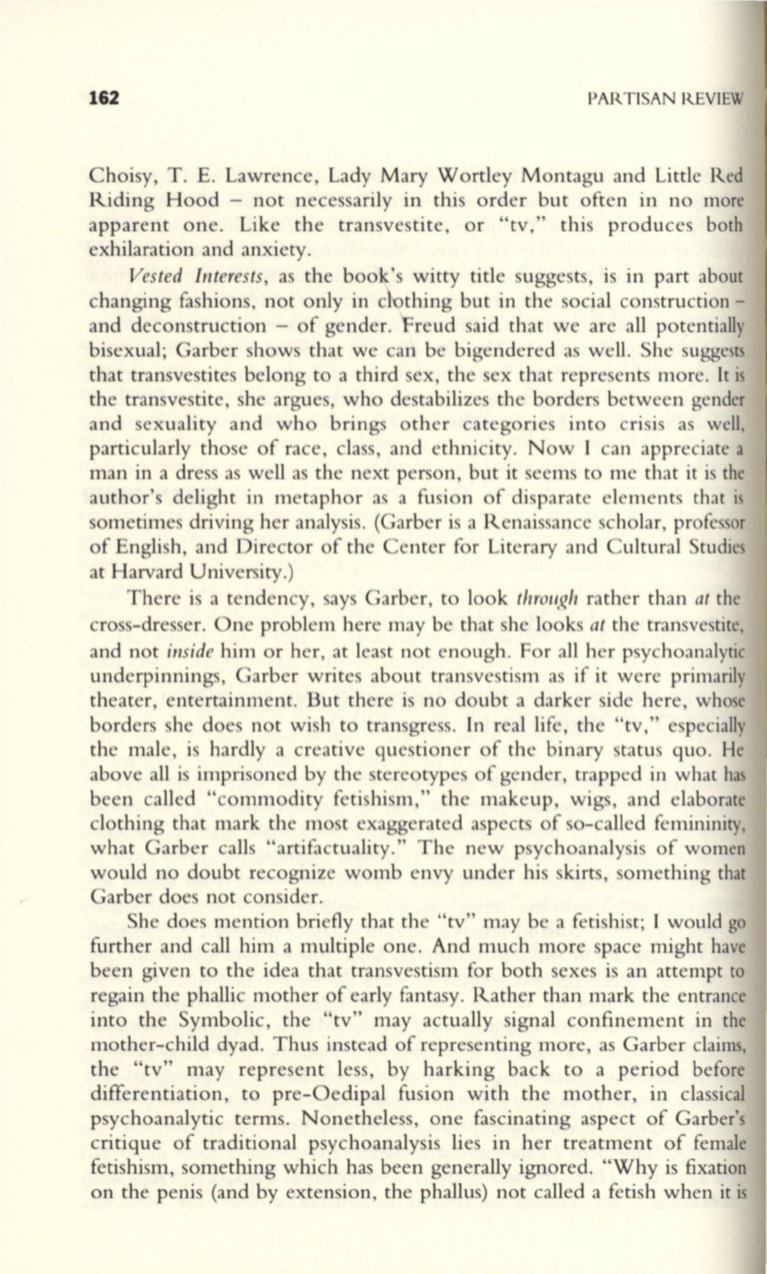
162
PARTISAN REVIEW
Choisy, T. E . Lawrence, Lady Mary Wortley Montagu and Little Red
Riding Hood - not necessarily in this order but often in no more
apparent one. Like the transvestite, or "tv," this produces both
exhilaration and anxiety.
Vested Interests,
as the book's witty title suggests, is in part about
changing fashions, not only in dothing but in the social construction -
and deconstruction - of gender. Freud said that we are all potentially
bisexual; Garber shows that we can be bigendered as well. She suggests
that transvestites belong to a third sex, the sex that represents more. It is
the transvestite, she argues, who destabilizes the borders between gender
and sexuality and who brings other categories into crisis as well,
particularly those of race, class, and ethnicity. Now I can appreciate a
man in a dress as well as the next person, but it seems to me that it is the
author's delight in metaphor as a fusion of disparate elements that is
sometimes driving her analysis. (Garber is a Renaissance scholar, professor
of English, and Director of the Center for Literary and Cultural Studies
at Harvard University.)
There is a tendency, says Garber, to look
throllgh
rather than
at
the
cross-dresser. One problem here may be that she looks
at
the transvestite,
and not
inside
him or her, at least not enough. For all her psychoanalytic
underpinnings, Garber writes about transvestism as if it were primarily
theater, entertainment. But there is no doubt a darker side here, whose
borders she does not wish to transgress. In real life, the "tv," especially
the male, is hardly a creative questioner of the binary status quo. He
above all is imprisoned by the stereotypes of gender, trapped in what has
been called "commodity fetishism," the makeup, wigs, and elaborate
clothing that mark the most exaggerated aspects of so-called femininity,
what Garber calls "artifactuality." The new psychoanalysis of women
would no doubt recognize womb envy under his skirts, something that
Garber does not consider.
She does mention briefly that the "tv" may be a fetishist; I would go
further and call him a multiple one. And much more space might have
been given to the idea that transvestism for both sexes is an attempt to
regain the phallic mother of early fantasy. Rather than mark the entrance
into the Symbolic, the "tv" may actually signal confinement in the
mother-child dyad. Thus instead of representing more, as Garber claims,
the "tv" may represent less, by harking back to a period before
differentiation, to pre-Oedipal fusion with the mother, in classical
psychoanalytic terms. Nonetheless, one fascinating aspect of Garber's
critique of traditional psychoanalysis lies in her treatment of female
fetishism, something which has been generally ignored. "Why is fixation
on the penis (and by extension, the phallus) not called a fetish when it is


